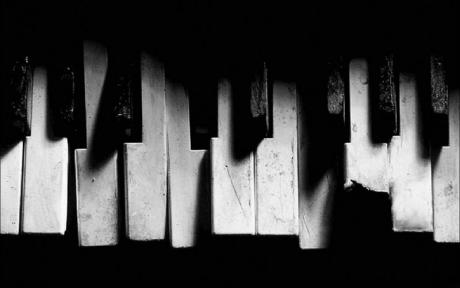Rockové klávesy - Emulace kytarového zvuku
Greetings, readers, and welcome to another installment of Rock keyboards! This week I wanted to continue our discussion of imitating other instruments with keyboards. So far we've covered saxes, brass, strings and winds. This month, I wanted to speak about emulating guitar. We will be looking at two great solos by guitarists who were also great keyboardists
Edgar Winter's Frankenstein
The Edgar Winter group shocked the world in 1973 with their instrumental hit, Frankenstein, named one of the Top 25 Best Rock Instrumentals by Rolling Stone Magazine. Group leader, Edgar Winter was one of the first artists to popularize not only playing a keyboard solo in a rock band, but also wearing a synth with a strap like a guitarist. The synth Winter used for his iconic solo was the ARP 2600, a semi modular subtractive synthesizer made by Dennis Colin and manufactured by ARP instruments. Check out this live video link to see Edgar in action on the ARP and a bunch of other instruments as well:
at 5:07, Winter plays some super cool hammer ons with both hands. I’ve enclosed an exercise influenced by his riffs below: (insert example 1)
In the first bar of Ex. 1 we start with 5ths in the left hand that are handed off too a C7sus4 shape in the right hand creating a lush minor 11 harmony. In bar 2, we move our 5ths up a step to A. Our right hand notes outline an Am9 arpeggio. Done quickly and on a monophonic synth patch, the riffs sound like a guitarist tapping hammer ons.
Jump solo by Eddie Van Halen
The second guitarist in our discussion is arguably the most important electric guitarist of the last 40 years, Eddie Van Halen. Van Halen, who in the late 70s reinvented the way guitarists used the instrument, was actually a pianist when he started to play music. His solo on the 1984 hit, Jump, was originally played on an amazing polysynth, the Oberheim OB X. The OB X had a super fat sound and was very well known for its cutting brass sounds like the one used on Jump. The synth was replaced on subsequent Van Halen tours and in the MTV video by Ob-XA which had much more stable electronics. in the last third of the solo, Van Halen repeats a sus4 motive with a moving baseline. I’ve come up with an exercise illustrating this concept. Pull up a fat analog brass sound to get the flavor (insert ex 2):
Here's a video link to the tune:
Bar 1 and 2 of Ex. 2 have a C bass note with a deft 16th note Gsus4 arpeggio in the right hand, creating a cool C9 shape without the 3rd. Bar 3 and 4 keep the right hand where it is and move the bass note down a step making a very different chord, a Bb 6/9.
Tune in next month for part 2 of emulating guitar sounds with keyboard.
FRÁZE A HUDEBNÍ TERMÍNY
Semi-modular subtractive synthesizer: V minulosti už jsme narazili jak na subtraktivní, tak na modulární syntezátory. V čem jsou tedy jiné ty semimodulární? Zatímco u modulárních syntezátorů můžeme moduly (např. oscilátory nebo filtry) fyzicky vyměňovat (často se také prodávaly jednotlivě) a vzájemně je propojujeme kabely, u semimodulárních jsou většinou moduly pevnou součástí nástroje a často mají předdefinované pořadí, které však můžeme měnit. Způsob, jakým se to děje, se liší model od modelu. U typu ARP 2600, zmíněném v článku, bylo třeba použít propojovací kabely pouze tehdy, pokud uživatel zatoužil po jiném pořadí modulů, než jaké bylo přednastavené od výrobce.
Tapping hammer-ons: Vzhledem k tomu, že tento díl pojednává o imitaci zvuku elektrické kytary, měli bychom si udělat jasno v rozdílu mezi termíny „tapping“ a „hammering“. Někteří je totiž považují za synonymní, ale ono to s nimi je o něco složitější, a to především proto, že o jejich definicích nepanuje stoprocentní shoda. Hammering většina kytaristů vnímá jako techniku, kdy hráč první notu rozezní trsátkem (či prstem pravé ruky - leváci nechť si strany prohodí) a tu následující, vyšší, pouze „doklepne“ levou rukou (bez opětovného „drnknutí“ pravou rukou). Tapping by pak znamenal zahrání buď dodatečné nebo samostatné noty rychlým přimáčknutím struny pravou rukou na hmatník. Někdy se ale tapping hraje oběma rukama (tedy prsty se pouze ťuká na hmatník, ale nedrnká). A někteří moderní (obzvláště akustičtí) kytaristé navíc termín „tapping“ používají pro hraní flažoletů úderem pravé ruky o struny. Teď aby se v tom jeden vyznal!
More stable electronics: Proč mluví Brian o stabilnější elektronice? Především se jedná o ladění oscilátorů. Moderní klávesisté jsou tohoto naštěstí ušetřeni, ale u starších analogových syntezátorů záviselo ladění oscilátorů do velké míry na okolní teplotě. Přinést syntezátor z auta, zapojit jej a začít hrát, to většinou nešlo. Bylo nutné, aby si nástroj „zvykl“ na okolní teplotu, a pak oscilátory pracně naladit.





